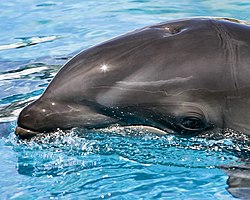Wholphin
Hybrid born from mating female common bottlenose dolphin and a male false killer whale From Wikipedia, the free encyclopedia
A wholphin (portmanteau of whale and dolphin) is an extremely rare cetacean hybrid born from a mating of a female common bottlenose dolphin (Tursiops truncatus) with a male false killer whale (Pseudorca crassidens).[1] The name implies a hybrid of whale and dolphin, though taxonomically, both are in the oceanic dolphin family, which is in the toothed whale clade. This type of hybrid was considered unexpected given the sometimes extreme size difference between a female common bottlenose dolphin (typically 2 meters long and 300 kilograms) and a male false killer whale (over 5 meters long and over 1,800 kg). Wholphins have been born in captivity and have also been reported in the wild.[2][3]
| Wholphin | |
|---|---|
 | |
| Kawili Kai, born to Kekaimalu (a female wholphin) by a male dolphin, at 9 months of age in September 2005 | |
| Scientific classification | |
| Domain: | Eukaryota |
| Kingdom: | Animalia |
| Phylum: | Chordata |
| Class: | Mammalia |
| Order: | Artiodactyla |
| Suborder: | Whippomorpha |
| Infraorder: | Cetacea |
| Superfamily: | Delphinoidea |
| Family: | Delphinidae |
| Hybrid: | Tursiops truncatus × Pseudorca crassidens |
Wholphins also exhibit physical and behavioural characteristics intermediate between those of their parent species. While much larger than most dolphins, the wholphin becomes an exceptional example of hybrid vigour.[clarification needed]
Examples
Summarize
Perspective

The first recorded wholphin was born in a Tokyo SeaWorld in 1981; he died after 200 days.[4]
The first wholphin in the United States and the first to survive was Kekaimalu, born at Sea Life Park in Hawaii on May 15, 1985; her name means "from the peaceful ocean".[4] Kekaimalu proved fertile when she gave birth at a very young age. John Blanchard, a trainer at Sea Life Park, has said about Kekaimalu: [5]
“The wholphin was darker than the other dolphins, and her nose looked like it was chopped off… [she] represented an unusual example of hybridization between two species of dolphin with markedly different sizes and appearances.”
In 1991, Kekaimalu gave birth, to her daughter, Pohaikealoha, with a unknown, male dolphin. For two years, she cared for the calf, but did not nurse it; it was hand-reared by trainers. Pohaikealoha died at age 9. On December 23, 2004, Kekaimalu had her third calf, daughter Kawili Kai, sired by a male bottlenose. The calf was nursed and was very playful. Only months after birth, it was the size of a one-year-old bottlenose dolphin.[6] All three calves were three-quarters bottlenose dolphin and one-quarter false killer whale.[7] Kekaimalu died on July 8, 2024 at the age of 39. [8] Kawili Kai remains in captivity in Sea Life Park.[9]
Family tree
| Tanui Hahai (false killer whale) ♂ | Punahele (bottlenose dolphin) ♀ | ||||||||||||||||||||||||||||||||||||||||
| Unknown dolphin ♂ | Kekaimalu (wholphin) ♀ | bottlenose dolphin ♂ | |||||||||||||||||||||||||||||||||||||||
| Unnamed calf | Pohaikealoha ♀ | Kawili Kai ♀ | |||||||||||||||||||||||||||||||||||||||
Capabilities and behaviour
Wholphin behavior represents both parent species. They are intelligent, highly social, and can be trained to do complex tasks; shared traits of false killer whales and bottlenose dolphins alike. Captive wholphins have been observed to be playful and show a great deal of curiosity about their surroundings, the same as bottlenose dolphins. Despite being recorded in the wild, only a few confirmed sightings of wholphins have been seen in nature.[citation needed] Although natural sightings are improbable due to the differences in habitat preference and social structure between the parent species, this is not impossible. They are also a very smart and intelligent animal.
Exterior and physical description
Wholphins will also have mixed traits from their parents. They are mostly smaller in size compared to the false killer whales but larger than the bottlenose dolphins. Their coloring will be mostly a dark grey, with the body proportion and dental features falling between those of the two species. For example, wholphins do have more teeth than bottlenose dolphins but fewer than false killer whales on average, showing their hybrid nature.[3]
References
External links
Wikiwand - on
Seamless Wikipedia browsing. On steroids.
